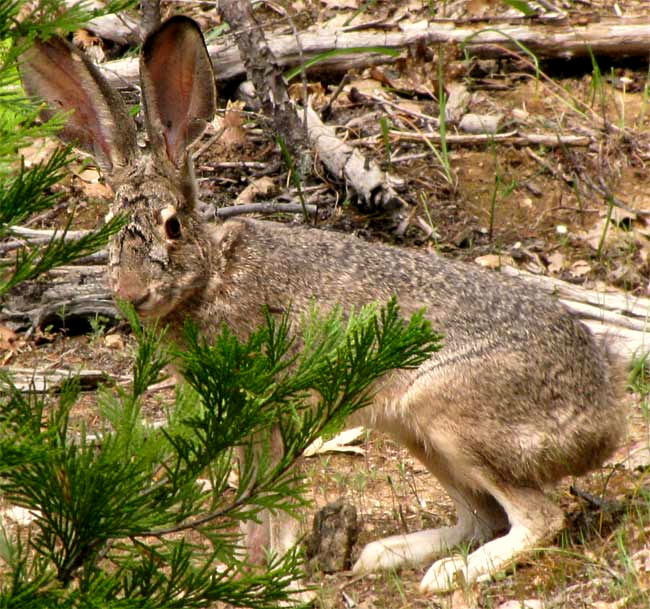Excerpts from Jim Conrad's
Naturalist Newsletter

from the May 3, 2009 Newsletter, issued from the Siskiyou Mountains west of Grants Pass, Oregon:
CASUAL JACKRABBIT
I'd heard about the big rabbit often seen patrolling the road and exploring the lawn, and who never seemed too concerned about humans and their cars. Wednesday as I was snipping manzanita twigs for firewood I looked up to see him about 15 feet from me watching me as casually as a rabbit can manage. He puttered around twitching his nose as I retrieved the camera from my pocket and took the picture shown above.
He's a jackrabbit, not a cottontail, as his long ears and legs attest. Specifically he's a Black-tailed Jackrabbit, LEPUS CALIFORNICUS.
Oregon is home to seven members of the Rabbit Family, the Leporidae: the Pygmy and Brush Rabbits, Eastern and Mountain Cottontails, Snowshoe Hares, and Black-tailed and White-tailed Jackrabbits. Eastern Cottontails are introduced, invasive species occurring only here and there. Of the seven species, only the small Brush Rabbit, the Snowshoe Hare at higher elevations, and the Black-tailed Jackrabbit occur in southwestern Oregon. Rabbit-identifying around here is pretty easy.
Those black lines on our jackrabbit's face are normal for this species, constituting camouflage breaking up the face's contours.
Sometimes Black-tailed Jackrabbits are called Desert Hares, and that name is appropriate because the species is most abundantly found in desert, prairie and chaparral communities, and jackrabbits are considered to be hares. During my months of desert wandering in 1988 writing "Springs Comes to the Desert" probably the most commonly encountered sign of wildlife was Black-tailed Jackrabbit droppings. I wrote:
"In places their excreta lies as thick as chicken manure in a farmer's pen. Both jackrabbits and cottontails leave dry, spherical, pellet-like scats ("scats" is a general term for animal droppings) that look like marble-sized, dried-out balls of varnished, yellow sawdust. The handlens shows this 'sawdust' to be clippings of grass stems and leaves that are in such an undigested state that it's hard to see how the animals could have derived much nutrition from them. The only difference I find between jackrabbit and cottontail pellets is that the jackrabbits' are slightly larger, averaging about half an inch in diameter, while the cottontails' are only about 3/8 of an inch.
"Spring Comes to The Desert" is available online at http://www.backyardnature.net/desert/ and can be downloaded in book form, for free, at http://www.backyardnature.net/j/books/index.htm#desert.
issued September 16, 2020 from the valley of the Dry Frio River in northern Uvalde County, southwestern Texas:
LATE AFTERNOON JACKRABBIT
By 5PM I've put in a good day of physical labor and working on my upcoming book, and am tired. As the Sun dips toward the horizon I like to sit in the late-afternoon coolness, in the sunlight, reading. As I read, usually the Black-tailed Jackrabbit shown below orbits all around me, at a good distance.

The rabbit likes to bask in the sunlight just as I, and now that we're having a few rains the grass is tender and green, looking springy but feeling fallish. We have cottontails here, too, but in general shape they're more rounded, with shorter ears and legs, and less projecting snouts. In our mostly hot climate, the jackrabbits' lankiness increases surface area per unit volume, and since heat radiates from the surface, the floppy ears and lankiness help him keep cool.
from the May 8, 2005 Newsletter, issued from Sierra Nevada Foothills east of Sacramento, California:
BLACKTAIL JACKRABBIT AT DAWN
Every now and then as I'm jogging at dawn I round a corner, surprise a rabbit in the road, and he takes off running hard away from me. Just a glance at the critter is enough to convince me that he's not a cottontail. He's a lot larger, his much longer ears stand straight up as he runs, and his manner of running is also different -- less "hoppy" and more flat-footed-racy. He's a Blacktail Jackrabbit, what old timers sometimes call Jackass Rabbit, LEPUS CALIFORNICUS.
An Eastern Cottontail's head and body are 14-17 inches long while a Blacktail Jackrabbit's is 17-21. Cottontails weigh 2-4 pounds and jackrabbits 3-7. A cottontail's ears are 2-3 inches long while a jackrabbit's are 6-7. When cottontails are spooked they tend to hide in nearby thickets or burrows, but jackrabbits hightail it overland. An escaping jackrabbit leaps two or three yards at a bound, touching the ground only with his toes.
Eastern Cottontails don't occur this far west but in the foothill valley bottoms we do have Mountain Cottontails, which look a lot like their Eastern cousins. We also have Whitetail Jackrabbits, even larger than Blacktails, found higher in elevation than here.
With all the lush nibblings available nowadays I think our jackrabbits must be thinking they have it made. However, soon the dry season will hit and the herbaceous layer will dry up fast. Then we'll see if the garden fence does its job keeping jackrabbits at bay.